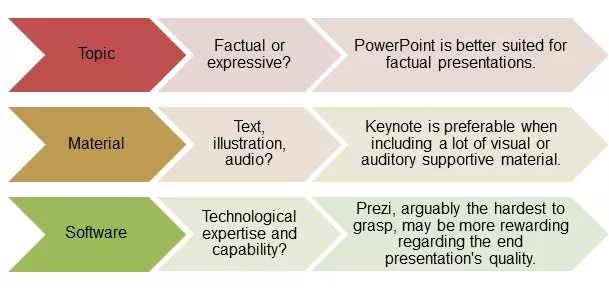How to Make a Perfect Presentation
This piece of content has been developed by IvyPanda's editorial team.
No AI was involved in the creation process; only qualified experts contributed.
The information, facts, and sources presented in the text have been carefully checked and verified.
You are free to use it with proper referencing.
Formulating an excellent presentation is a matter of balancing information and demonstration, ideally creating an easy-to-follow format that reflects the main text. A presentation is a method of demonstrating the most important aspects of your project, accompanied by supporting materials such as illustrations. Among the presentation-making software packages currently available, three programs stand out: PowerPoint, Prezi, and Keynote, each having its own specific qualities and guidelines. Learning to create presentations that help the viewer immediately understand the key points is a necessary skill at any level of education as it demonstrates the creator’s competency and grasp of the material.
Create a Presentation in PowerPoint: Guidelines
The most popular presentation software for Windows computers is Microsoft PowerPoint, which offers one of the most recognizable looks due to the quality and variety of the built-in templates and the clear mechanics that are available. To create a PowerPoint presentation, follow these four simple steps:
- Step 1. Create a Title slide, entering the title and details such as the author’s name, course, and date.
- Step 2. Choose a template that will set the tone throughout the presentation.
- Step 3. Create new slide types, incorporating the material you want to display.
- Step 4. Save your presentation by naming it using your last name and the topic.
Creating a PowerPoint presentation is simple and straightforward, but you have to carefully choose the material to include, keeping in mind the fact that appearance is vital. Make sure your text is large enough to read, easy to decipher against the chosen background (e.g., avoid yellow text on a white background), and concise, getting your point across using limited words or illustrations.
Create a Keynote Presentation: Specifics
For users of Apple products, a Mac alternative similar to PowerPoint would be Keynote, whose smoother mechanics may be harder to grasp. The better quality of its animated transitions between slides and heightened control over on-slide customizable content make Keynote ideal for presentations that have many illustrations or videos or recorded audio. While the general process of creating presentations is similar to that of PowerPoint, the mechanics of Keynote make it more difficult to use for users who are unfamiliar with Apple controls. However, after overcoming the software specifics, the user is left with a presentation that not only looks fresh but is also better tailored toward a “show-don’t-tell” approach frequently lacking in PowerPoint presentations.
Create a Presentation in Prezi: Recommendations
Prezi is a pricier multi-platform presentation-making software ideal for animated presentations on topics that require smooth and frequent transitions between slides. Prezi’s “slides” are sections of a background “big picture” that are focused on and augmented with supportive information, making its presentations stand out from more traditional formats. However, the benefits that make Prezi attractive also make it hard to use as the software may cause motion sickness, lend itself to lack of clarity without a presenter, and distract viewers with its attention-grabbing features.
Choosing Presentation Software
Picking one of these three programs is not a matter of choosing only according to the extent of your computer’s abilities. As a first step, it is necessary to consider the specifics of the topic and how you, as the presenter, will go about covering it. Next, examine the materials that you will include as well as the features and elements that will constitute the “face” of your presentation. Finally, do not forget about your abilities; for example, if you are used to working with Microsoft products, you will not be able to learn the mechanics of Keynote quickly.
Summary

PowerPoint, Keynote, and Prezi each have their drawbacks and benefits, producing varied and unique products. Understanding the purpose behind creating the presentation as well as its target audience and topic specifications helps in determining which software to use. Getting to know the programs’ workings before choosing any of them is a definite bonus and allows an educated guess regarding their benefits to the project.